Introduction
The Crusades were a series of religious and political wars fought between 1096 and 1291 for control of the Holy Land. Pope Urban II initiated the First Crusade (1096–1102) in order to aid the Christian Byzantine Empire, which was under attack by Muslim Seljuk Turks. As a result of this crusade, Europeans captured Jerusalem in 1099. Muslims quickly unified against the Christian invading and occupying force and the two groups battled in subsequent wars for control of the Holy Land. By 1291 the Muslims firmly controlled Jerusalem and the coastal areas, which remained in Islamic hands until the twentieth century.
The crusading movement involved men and women from every country in Europe and touched upon almost every aspect of daily life, from the Church and religious thought, to politics and economics. It also found its way into the arts, as patrons and artists from diverse backgrounds and traditions were brought together to create new forms of expression. Frescos, mosaics, sculptures, and even coins reflected a blend of Western (Latin/Catholic) and Eastern (Byzantine/Eastern Christian) traditions. Crusaders appeared in histories as well as in French and German epic poetry from the twelfth century, such as the Chanson d’Antioche, an account of the 1098 siege in Antioch.
The crusading movement involved men and women from every country in Europe and touched upon almost every aspect of daily life, from the Church and religious thought, to politics and economics.
Christians understood the Crusades as a path to salvation for those who participated. As the French monk Guilbert of Nogent wrote in his twelfth century chronicle of the Crusades, “God has instituted in our time holy wars, so that the order of knights and the crowd running in its wake… might find a new way of gaining salvation. And so they are not forced to abandon secular affairs completely by choosing the monastic life or any religious profession, as used to be the custom, but can attain in some measure God’s grace while pursuing their own careers, with the liberty and in the dress to which they are accustomed.” Those who “took up the cross” were recipients of both spiritual and earthly rewards. The spiritual reward was the indulgence, or the forgiveness, of sins. The earthly rewards included plunder from conquest, forgiveness of debts, and freedom from taxes, as well as fame and political power. Crusaders did not only fight for control of the Holy Land; they also worked to secure the Church’s power in Europe. Like the wars against the Muslims, these conflicts were promoted by various popes in Christ’s name and led by crusaders who took vows and received special privileges and indulgences. The “enemies” of the Church in Europe included people who were not Christians. It also included Christians who were labeled heretics, that is, people who challenged the official teachings of the Church or who questioned the pope’s power and authority.
Millions of people, Christian and non-Christian, soldiers and noncombatants lost their lives during the Crusades. In addition to the enormous loss of life, the debt incurred and other economic costs associated with the multiple excursions to the Middle East impacted all levels of society, from individual families and villages, to budding nation-states. The wars also resulted in the destruction of cities and towns that lay in the crusaders’ wake. In his Decline and Fall of the Roman Empire, Edward Gibbon refers to the Crusades as an event in which “the lives and labours of millions, which were buried in the East, would have been more profitably employed in the improvement of their native country.”
Beginning in 1095 with Pope Urban II’s proclamation and concluding, according to some historians, with Napoleon’s conquest of Malta in 1798, the Crusades had a lasting impact on European and Middle Eastern culture and politics that still continues to this day. The following documents offer insight into the religious and social motivations and benefits for undertaking a crusade, as well as a glimpse into the more mundane administrative details required to make this transcontinental excursion to the Holy Land. They also suggest how the Crusades were both commemorated and criticized in literature and history for centuries after they had ended.
Please consider the following questions as you review the documents:
- What were Western Christian religious beliefs, political relationships, and personal values during the Middle Ages?
- How did the motives, organization, and effects of the Crusades change over time?
- How have writers from the eleventh century on criticized the Crusaders’ goals and actions?
The Call to Crusade
In the years approaching the twelfth century, some Christians began to believe that an individual’s thoughts and meditations—in addition to one’s actions—were an important indicator of piety and goodness. Devout Christians increasingly pursued religious pilgrimages, or journeys, to the places where Jesus lived, died, and was buried. At the time of the First Crusade, the Church taught that an individual’s sins could be remedied, at least in theory, by acts of penance that demonstrated remorse and a desire for forgiveness. As communications through Central Europe improved, and Italian trade in the Mediterranean increased, more Western European people than ever before could journey or make a pilgrimage to the Holy Land and seek penance for past sins. The First Crusade, proposed by Pope Urban II in 1095, was undertaken by many as a devotional act of pilgrimage.
A literal transcription of Urban’s words at Clermont does not exist, however there are multiple recorded versions of the speech. This version was written by the priest Fulcher of Chartes, who was most likely present when Urban spoke at Clermont. Fulcher of Chartes traveled to Constantinople during the First Crusade and witnessed the events that he describes in his famous chronicles.
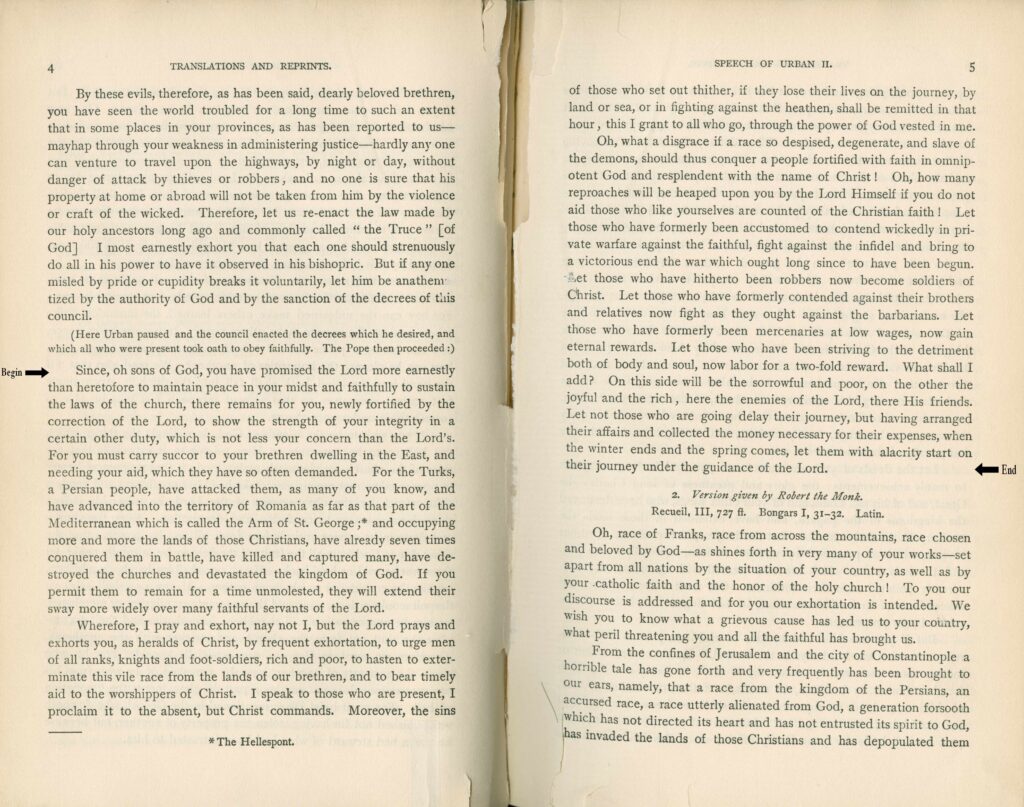
Questions to Consider:
- What task does Urban II place before the Christian people of Europe? What is the spiritual purpose of this task? What is the political purpose?
- What is the “twofold reward” for undertaking this task? What punishments could result from inaction? Who will receive these rewards or benefit from them?
- What does Urban, or the Church as a whole, stand to gain by the Crusades? How will the Crusades affect the pope’s or the Church’s in Europe and the world?
Christian Devotion and Reward in the Crusades
The Church promoted taking the cross and going on to the Holy Land as a demonstration of Christian love and devotion to God. Likewise, knights were taught that to be a good Christian knight, one must undertake acts of love and charity. Among these acts of charity were “Love of God” and “Love of Neighbor.” Defending the Holy Land and protecting Christians in their time of need were seen as acts of loving one’s neighbor. Bernard of Clairvoix, commenting on the Muslim victories in the Holy Land wrote, “If we harden our hearts and pay little attention… where is our love of God, where is our love for our neighbor?” While there were additional motivations for taking up the cross—opportunity for economic or political gain, desire for adventure, and the feudal obligation to follow one’s lord into battle—to become a soldier for Christ was to express total devotion to God. According to historian Jonathan Riley-Smith, taking up the cross was based on Christ’s statement: “Whoever doth not carry his cross and come after me, cannot be my disciple” (Luke 14. 27). Underscoring this belief, priests encouraged participation in the Crusades by praising acts of devotion to God and invoking fear of the last judgment for failure to act.
This poem portrays the Crusades as the ultimate act of Christian devotion:
Anonymous, “You Who Love,” in Les chansons de croisade, 20-22 (c. 1189)
Popes and kings granted special privileges to crusaders to reinforce this message. Initially, Pope Urban II promised forgiveness of sins to those who took up the cross. However, as the wars continued, Church and political leaders found that they had to promise additional benefits, beyond the spiritual, to encourage participation. These benefits included forgiveness of debts and interest payments, protection of property and family, even different courts of justice for those crusaders who commit criminal acts.
This document is an account of the privileges granted to crusaders by Pope Eugene III:
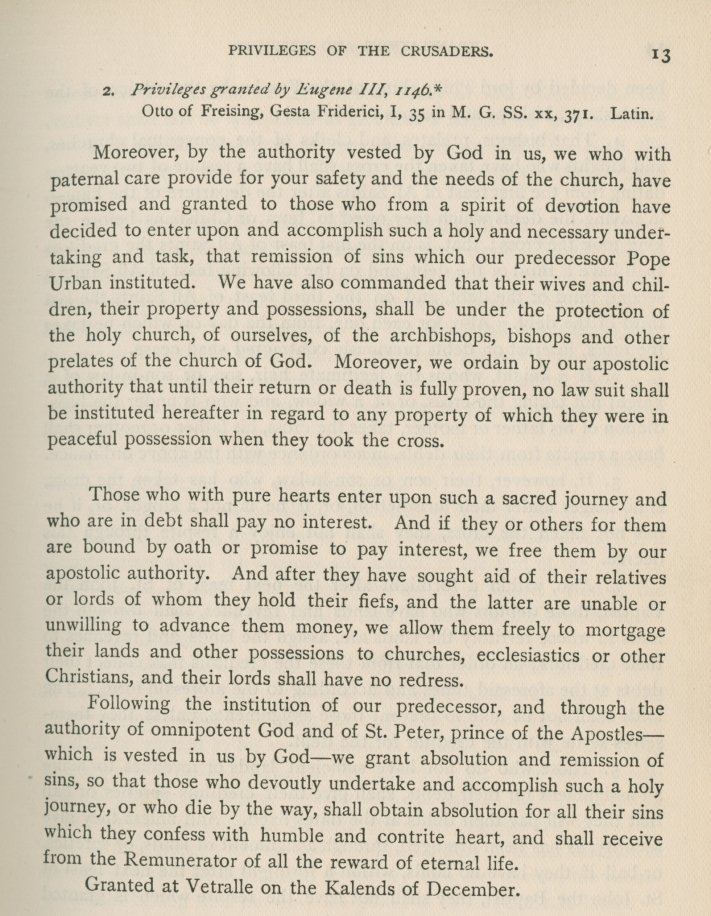
Questions to Consider:
- According to Pope Eugene III, what types of actions will the Church take on behalf of crusaders?
- Review the privileges granted to crusaders outlined in this document. Hypothesize the types of problems encountered by families when a member went on crusade.
- How does this document reveal the relationship between Church spiritual and secular (non-religious) authority?
- What is the message of the poem “You Who Love with True Love”?
- The poet writes, “A sensible merchant spends money from his purse.” What is implied by this line?
- According to the poem, what is promised to those who take up the cross? What lies ahead for those who procrastinate?
- How does a Christian’s devotion to God compare to the feudal relationship between a lord and vassal?
Images of the Crusades

British interest in the Crusades increased following the translation of Italian poet Torquato Tasso’s Gerusalemme liberata (“Jerusalem Delivered”) into English in 1600. In 1639 Thomas Fuller, an English historian, published the first, modern, full-length account of the Crusades in English. Three more editions of his four-volume History of the Holy Warre appeared within the next decade. Fuller researched his subject extensively, drew on numerous sources, and included maps and a supplemental commentary in his history. Fuller was sharply critical of the papacy for promoting the Crusades and devoted nine chapters of The History of the Holy Warre to describing their failure.
At right is the frontispiece of the first edition of Fuller’s history. A portrait of Baldwin, King of the Crusader state of Jerusalem (1100–1118), appears on the top left of the image and, to the right, a portrait of Saladin, the Muslim sultan who defeated the crusaders and captured Jerusalem in 1187. The image below the portraits shows the crusaders’ advance and retreat between Europe and Jerusalem, and the words, “We went out full but returned empty.” The Latin phrase Vestigia pauca retrorfum in the upper right of the image means “few lived to return home.”
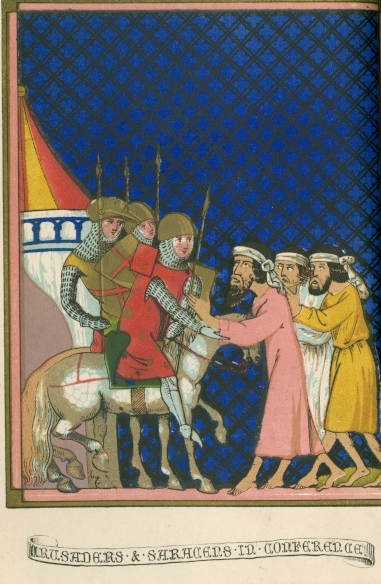
British publisher Henry George Bohn included the image at right as the frontispiece to his Chronicles of the Crusades. Bohn writes that the image is a reproduction from a fourteenth-century illuminated manuscript. It portrays an event in 1270, when three French knights “were accosted by three Saracen knights requesting baptism.” While the Frenchmen spoke with the Saracens (or Muslims), they were attacked, and “sixty Christians were slain before the infidels were put to flight.”
Questions to Consider:
- Fuller’s illustration is a map of the Third Crusade. Describe the various groups that are represented here. Who is taking this journey?
- Describe the two men portrayed at the top of the image. How do you interpret the meaning of the text surrounding the portraits?
- Explain the symbolism of the two buckets at the top of the image. What is implied by the phrase “We went full but returned empty”?
- Describe the image of “Crusaders & Saracens in Conference.” How do the French knights and the Muslims appear? What do their clothes and postures convey?
- Why do you think this event—in which Muslims who appeared to embrace Christianity acted as decoys before a military assault—seemed significant to historians of the Crusades?
Logistics of a Crusade
While anyone could join in a crusade, it became clear in later crusades that success often depended on having well-qualified personnel on the battlefield. Those best prepared came from the warrior classes: the knights, heavy cavalry (armored front-line troops), and support personnel such as bowmen, foot soldiers, and siege engineers. Other strategic personnel included those with special skills, including priests who were literate and could perform church rituals as well as administrative tasks, merchants who controlled the supplies, surgeons, and members of the crusader lord’s household staff. In later crusades, sailors were crucial as the journey to the Holy Land involved sea voyages. However, the knights were the core of the crusading forces, and it was under their leadership that the armies were organized.
Participating in a crusade became widely accepted as an important feature of knightly behavior. Deciding who would go on crusade was dictated by the social and political structure of the region. If a king “took up the cross” or undertook a crusade, it was assumed that those in his circle would be obligated to join him out of political loyalty or duty to him, rather than as an expression of religious devotion. As one knight observed in Jean de Joinville’s account of the Crusades, “if we do not take up the cross, we shall lose the favor of the king; if we do take it, we shall lose God’s favor, since we shall not be taking it for his sake, but through fear of displeasing the king.”
Kinship also influenced participation in a crusade. It was common for sons to accompany fathers, brothers to go with brothers, or uncles with nephews. The decision of which family members would take up the cross, and which would remain behind was often made collectively. The family members who remained behind were tasked with the maintenance and administration of the family property and position.
The Crusades, like all wars, were extremely expensive. For example, Louis IX spent an estimated 3,000,000 livres, or 12 times his annual income, on his first crusade in 1248 until his return in 1254. Expenses included provisions for Louis and his household, wages for the knight and soldiers, replacement and purchase of horses, mules and camels, shipping, gifts to crusaders, and Louis’ ransom after he was taken prisoner by the Egyptians in April 1250. Individual lords were also expected to contribute toward the costs of the crusade and ransom. Paying for the war was a continual concern for all those involved. Though there was the opportunity for plunder, the costs of the crusade were rarely offset by the captured treasure.
The following document identifies the knights who accompanied Louis IX on his first crusade (1217–1221) and describes their terms of agreement. It was published in the nineteenth century as an appendix to an English edition of Jean de Joinville’s Life of Saint Louis, which Joinville completed in 1309. Joinville was a counselor and close friend to the king. He led a successful effort to have Louis canonized (or deemed a saint) by the Catholic Church after Louis’ death in 1270.

Questions to Consider:
- What information does this list record? Why was this type of record keeping necessary?
- What does the document tell you about the organization and logistics of a crusade?
- How does it reflect lessons learned from previous crusades?
Critical Perspectives on the Crusades
The following poems offer critical perspectives on the Crusades from writers who lived through them. The first document, below, is an excerpt from Jean de Joinville’s Life of Saint Louis (published as Lord de Joinville’s Memoirs of Louis IX, King of France in this 1848 English edition). Joinville accompanied Louis IX of France on his first crusade (1217–1221) and was captured alongside the king when the Egyptians defeated the Christian army at al-Mansura, Egypt, in 1250. Joinville attributed these words to the Muslim poet Essahib-Giémal-Edden-Ben-Matroub.
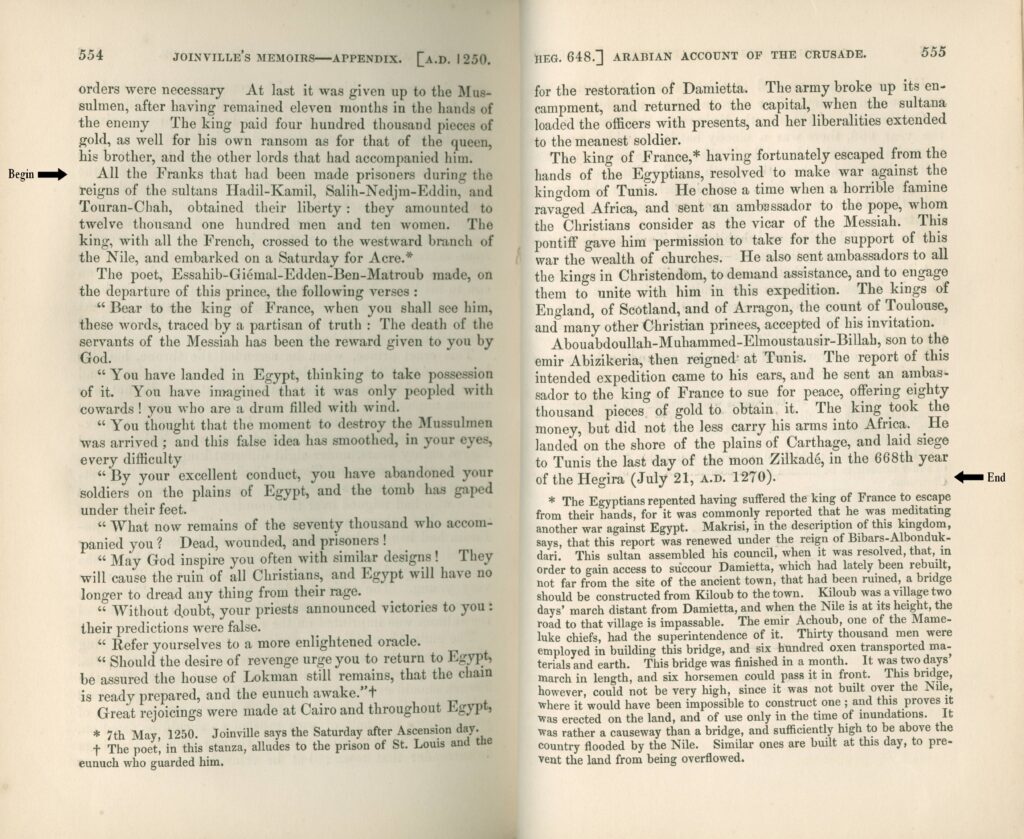
The second poem below was composed in 1267 by a trouvère known as Rutebeuf. Its original French title is “La Disputation du Croisé et du Décroisé,” or “Argument between Crusader and Non-crusader.” Trouvères were poets and minstrels working in northern France during the twelfth and thirteenth centuries. While their poems and songs primarily focused on the theme of courtly love, the trouvères turned their attention to the Crusades as well. This witty minstrel flourished during the reign of Louis IX, to whom many of his works are dedicated. At the time this poem was written, people began to question the value of participating in a crusade. However, Louis had already decided to go on his second crusade (1269–1272), much to the unhappiness of his wife, many of his ministers and members of the clergy, and even some of his subjects. Rutebeuf did not want to anger the monarch by criticizing his plans, and possibly risk the loss of his patronage, so he presented the argument about taking up the cross in a dialogue form. Louis IX died in Tunisia in 1270 during this second crusade.
Rutebeuf, “The Crusaders,” (1267) in The History of the Crusades, 458-460 (1820)
Questions to Consider:
- How does the Muslim poet Essahib-Giémal-Edden-Ben-Matroub portray Louis IX’s attempt to conquer Egypt in the name of Christianity? How might a crusader, who believed the conquest of the Muslims was God’s will, respond to this poem?
- This account, critical of crusader actions, appears in a European text. What point does the author want to make by including this account? What does the poem’s inclusion reveal about changing attitudes toward the Crusades?
- What criticisms of the Crusades does Rutebeuf present in his poem? What is the non-crusader’s attitude toward the clergy?
- How does the crusader defend his actions? Do the two speakers agree on any points?
- Do you think the poet favors one perspective over the other? How would you characterize his attitude towards the Crusades? Why might the poet feel this way?
A Scottish King’s Last Request
The fourteenth-century writer John Barbour has been called the father of Scottish poetry. Inspired by the French trouvères and their poems of romance and chivalry, Barbour celebrated the deeds of the Scottish king Robert the Bruce and his companions in this poem, completed in 1375.
John Barbour, “The Bruce, Being the Metrical History of Robert the Bruce King of Scots,” 160-161 (1489)
Robert the Bruce was born in 1274, and descended from Scots, Gaelic, and English nobility. In 1304 Bruce’s father died and gave him a viable claim to the throne. Two years later, Bruce met with his rival John Comyn at Greyfriars Church in Dumfries. A fight broke out, daggers were drawn, and Bruce killed Comyn near the Church altar. To commit murder in a church was seen as sacrilege and a mortal, or serious, sin. The Pope excommunicated Bruce, but the Bishop of Glasgow in Scotland absolved (or forgave) him and made plans for Bruce to quickly take the throne, which he did in 1306. Edward I, King of England, challenged Bruce’s claim to the Scottish throne, and the battle for Scottish independence continued until 1328 when the English king confirmed Scotland as a unique and independent kingdom with Robert at its head.
In his quest for Scottish sovereignty, Bruce made a sacred vow that, if God would grant Scotland freedom from English rule, he would take up the cross. Bruce died on June 7, 1329, without making the journey. However, before his death, he asked that his heart be removed and carried in battle “against God’s foes” on a crusade to the Holy Land, with eventual burial in Jerusalem in the Church of the Holy Sepulchre. This gesture was his penance for breaking his sacred vow to go on crusade during his lifetime and to atone for his past sins, including the sacrilegious murder of John Comyn in the Greyfriars church.
Bruce’s preserved heart was placed in a silver heart-shaped casket, which Sir James Douglas, his loyal subject, then carried on a chain around his neck. When a planned international crusade failed to occur, Douglas and his company of soldiers sailed to Spain where Alfonso XI of Castile was mounting a campaign against the Moorish (Muslim) kingdom of Granada. Douglas was killed in battle in 1330, and his body and the casket containing Bruce’s embalmed heart were left on the field. However, they were found and conveyed back to Scotland and, in accordance with Bruce’s written request, his heart was buried at Melrose Abbey in Roxburghshire, Scotland.
Questions to Consider:
- How does Robert Bruce’s final wish that his heart be taken to the Church of the Holy Sepulcher in Jerusalem reflect the importance of the Crusades to medieval people?
- How does the passage demonstrate the importance of oaths and vows? What role does loyalty play in the story? How do these values relate to the Crusades?

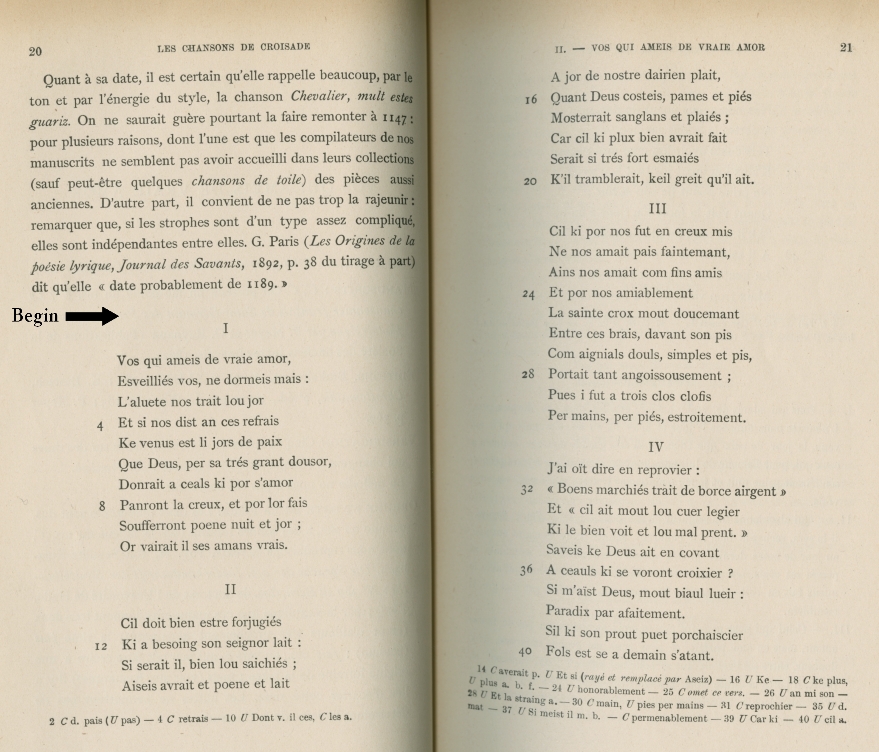
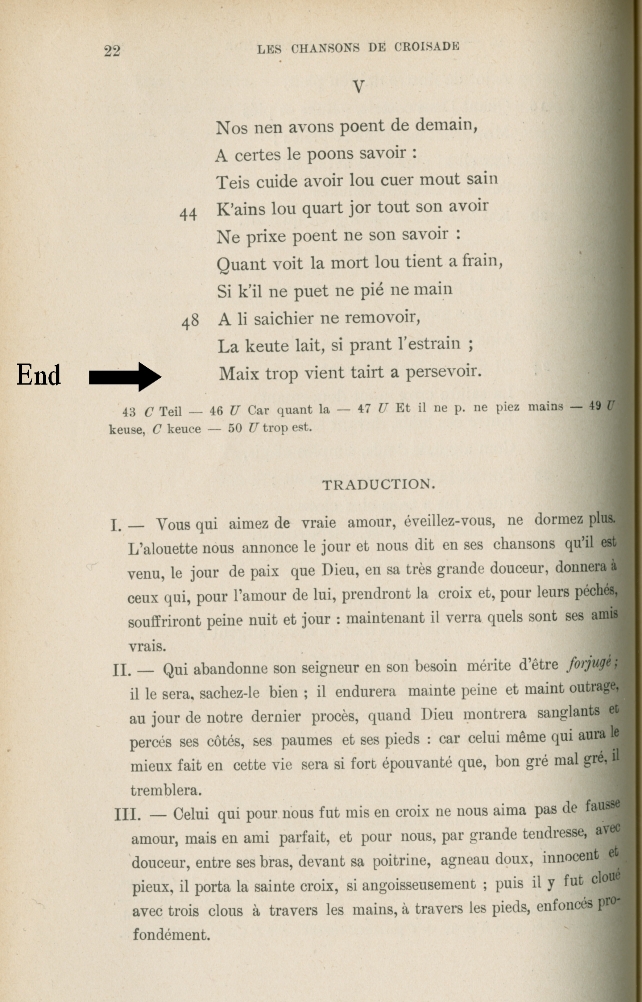





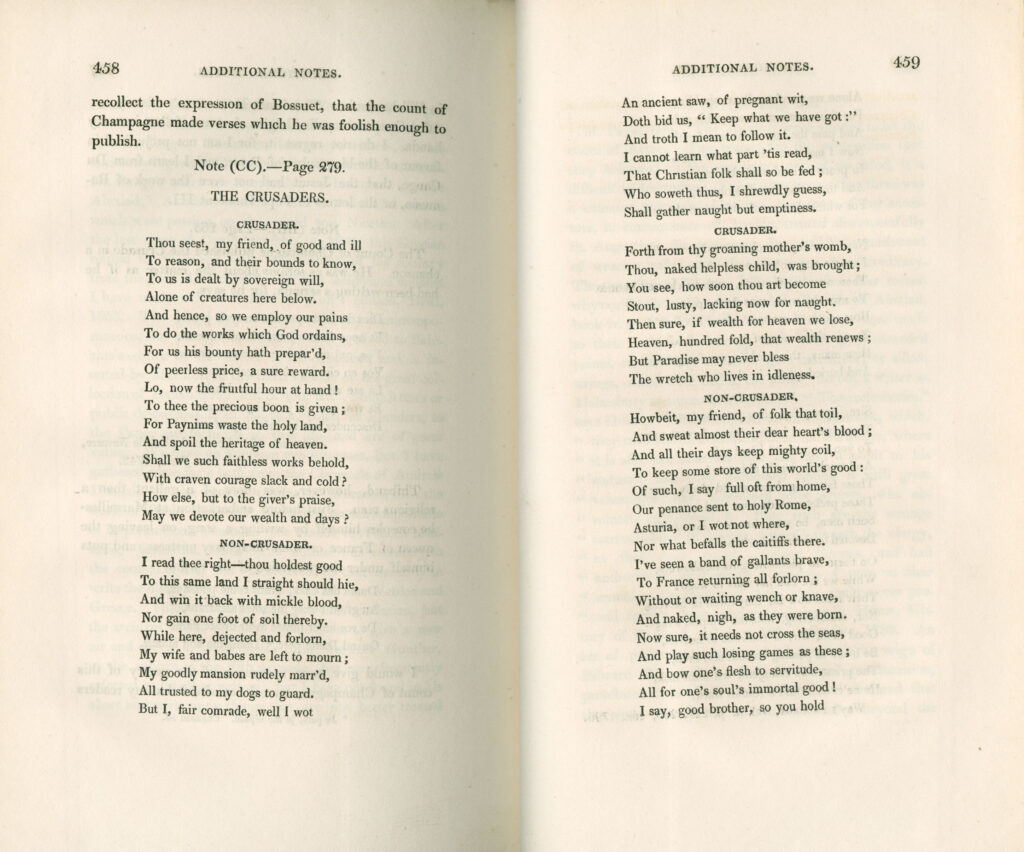
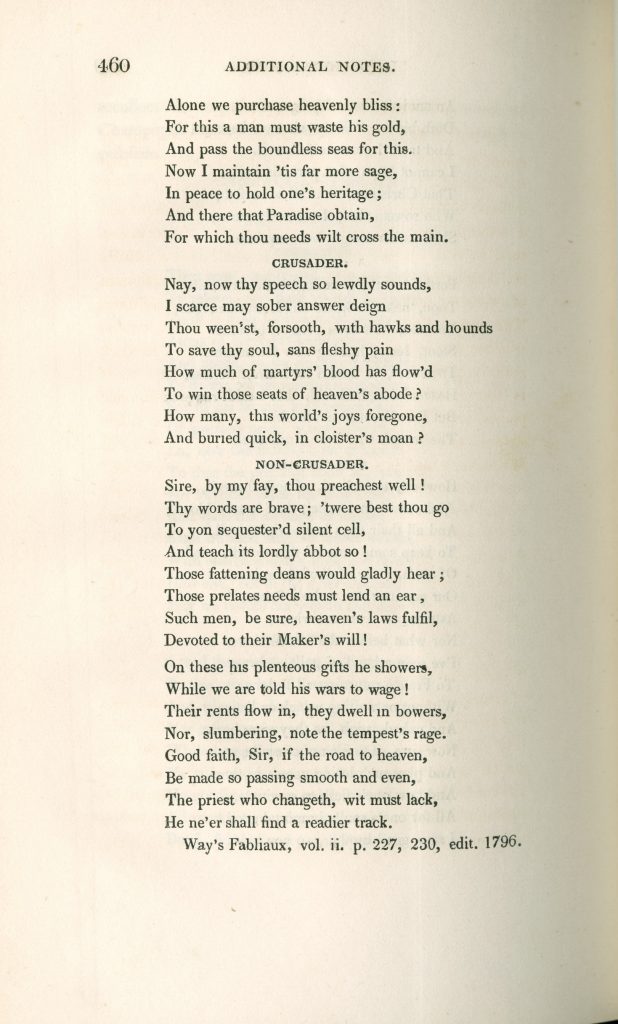
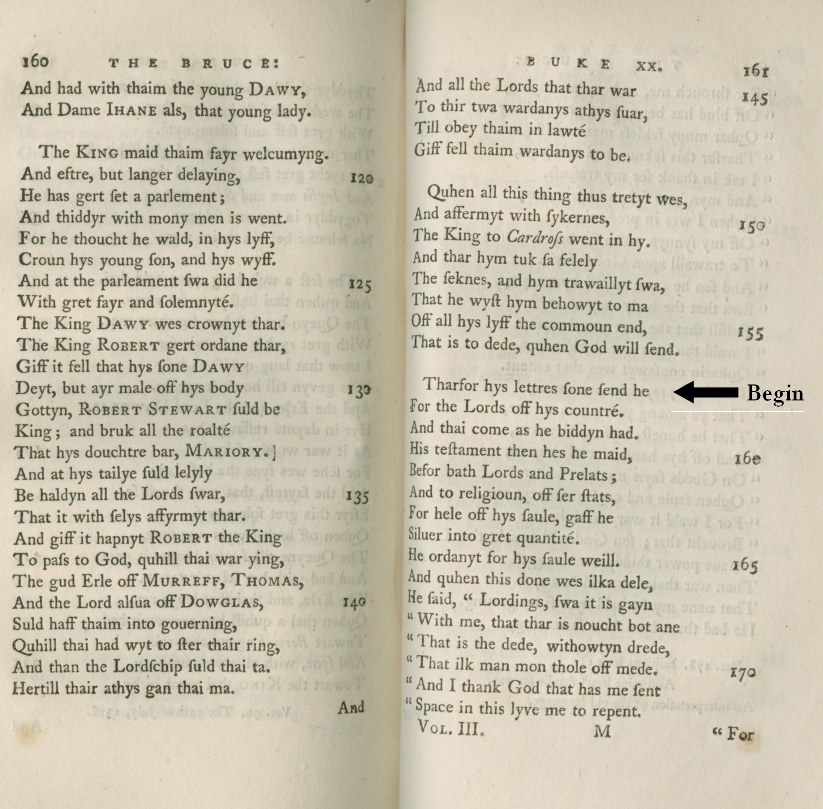
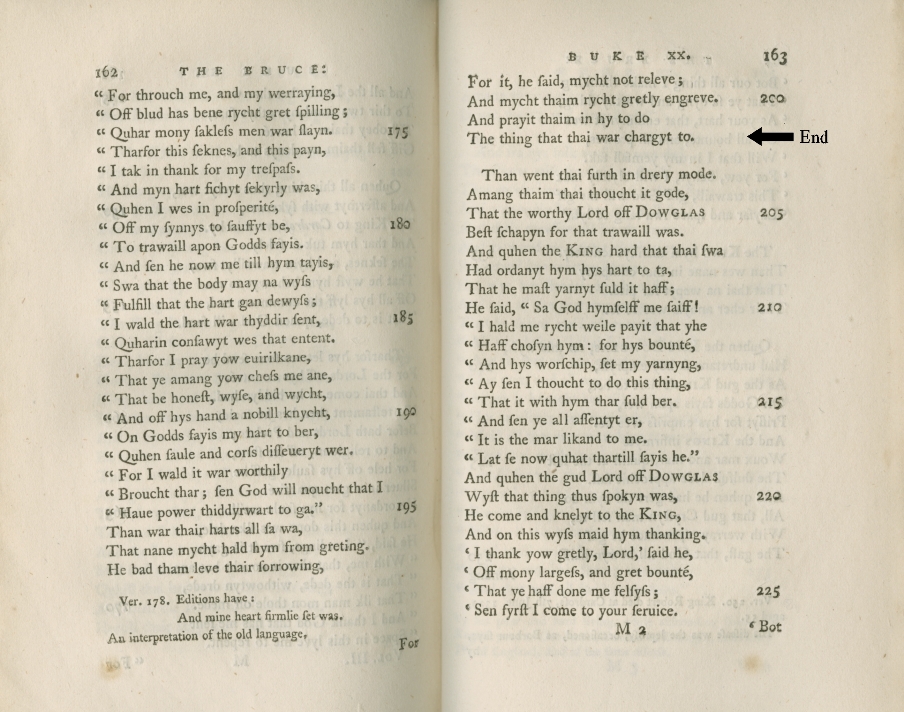
Further Reading
Riley-Smith, Jonathan, and Louise Riley-Smith. The Crusades: Idea and Reality, 1095–1274. London: Edward Arnold, 1981.
Riley-Smith, Jonathan. “Crusading as an Act of Love.” Journal of the Historical Association 65 (June 1980): 177–192.
Riley-Smith, Jonathan, ed. Oxford Illustrated History of the Crusades. 2001.
Harf-Lancner, Laurence. “Rutebeuf Chantre de la Croisade? La Disputation du Croise et du Decroise.” Synergies 2 (2007): 19–28. http://ressources-cla.univ-fcomte.fr/gerflint/Inde2/laurence.pdf.


